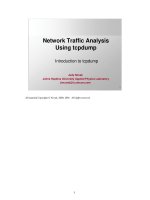Lecture no11 equivalence analysis using effective interest rates
Bạn đang xem bản rút gọn của tài liệu. Xem và tải ngay bản đầy đủ của tài liệu tại đây (250.52 KB, 14 trang )
Equivalence Calculations with
Effective Interest Rates
Lecture No.11
Chapter 4
Contemporary Engineering Economics
Copyright © 2016
Contemporary Engineering Economics, 6 th edition
Park
Copyright © 2016 by Pearson Education, Inc.
All Rights Reserved
Equivalence Calculations using
Effective Interest Rates
Contemporary Engineering Economics, 6 th edition
Park
Copyright © 2016 by Pearson Education, Inc.
All Rights Reserved
Case I: When Payment Period is Equal to
Compounding Period
Contemporary Engineering Economics, 6 th edition
Park
Copyright © 2016 by Pearson Education, Inc.
All Rights Reserved
Example 4.4: Calculating Auto Loan Payments
Given:
o
o
o
o
o
o
MSRP = $20,870
Discounts & Rebates = $2,443
Net sale price = $18,427
Down payment = $3,427
Dealer’s interest rate = 6.25% APR
Length of financing = 72 months
Find: the monthly payment (A)
Contemporary Engineering Economics, 6 th edition
Park
Copyright © 2016 by Pearson Education, Inc.
All Rights Reserved
Solution
Contemporary Engineering Economics, 6 th edition
Park
Copyright © 2016 by Pearson Education, Inc.
All Rights Reserved
Dollars Down in the Drain
o Suppose you drink a cup of coffee ($3.00 a cup)
every morning for 30 years.
o If you put the money in the bank for the same
period, how much would you have?
o Assume that your accounts earns a 5% interest
compounded daily.
Contemporary Engineering Economics, 6 th edition
Park
Copyright © 2016 by Pearson Education, Inc.
All Rights Reserved
Solution
• Payment period = daily
• Compounding period = daily
5%
i
0.0137% per day
365
N 30 365 10,950 days
F $3(F / A,0.0137%,10950)
$76,246
Contemporary Engineering Economics, 6 th edition
Park
Copyright © 2016 by Pearson Education, Inc.
All Rights Reserved
Case II: When Payment Periods Differ from
Compounding Periods
Step 1: Identify the following parameters.
• M = No. of compounding periods
• K = No. of payment periods per year
• C = No. of interest periods per payment period
Step 2: Compute the effective interest rate per payment
period.
C
i
[1
r
/
CK
]
1
• For discrete compounding
i e r /K 1
• For continuous compounding
Step 3: Find the total no. of payment periods.
• N = K (no. of years)
Step 4: Use i and N in the appropriate equivalence formula.
Contemporary Engineering Economics, 6 th edition
Park
Copyright © 2016 by Pearson Education, Inc.
All Rights Reserved
Example 4.5: Compounding Occurs More
Frequently than Payments Are Made
(Discrete Case)
Given:
o A = $1,500 per
quarter,
o r = 6% per year,
o M = 12
compounding
periods per year,
and
o N = 2 years
o Effective interest rate
per quarter
o
N = 4(2) = 8 Quarters
Find: F
Contemporary Engineering Economics, 6 th edition
Park
Copyright © 2016 by Pearson Education, Inc.
All Rights Reserved
Solution
Cash flow diagram
F = $1,500 (F/A, 1.5075%, 8)
= $14,216.24
Contemporary Engineering Economics, 6 th edition
Park
Copyright © 2016 by Pearson Education, Inc.
All Rights Reserved
Example 4.6: Compounding Is Less
Frequent than Payments
Given:
oA = $500 per month
oM = 4 compounding periods/year
oK = 12 payment periods/year
oC = 1/3 interest period per quarter
oN = 10 years or 120 months
Find: F
–
Contemporary Engineering Economics, 6 th edition
Park
Copyright © 2016 by Pearson Education, Inc.
All Rights Reserved
Solution
Cash Flow Diagram
F = $500 (F/A, 0.826%, 120)
= $101,907.89
Contemporary Engineering Economics, 6 th edition
Park
Copyright © 2016 by Pearson Education, Inc.
All Rights Reserved
A Decision Flow Chart on How to Compute the
Effective Interest Rate per Payment Period
Contemporary Engineering Economics, 6 th edition
Park
Copyright © 2016 by Pearson Education, Inc.
All Rights Reserved
Key Points
o Financial institutions often quote interest rate
based on an APR.
o In all financial analyses, we need to convert the
APR into an appropriate effective interest rate
based on a payment period.
o When payment period and interest period differ,
calculate an effective interest rate that covers the
payment period. Then use the appropriate interest
formulas to determine the equivalent values.
Contemporary Engineering Economics, 6 th edition
Park
Copyright © 2016 by Pearson Education, Inc.
All Rights Reserved









